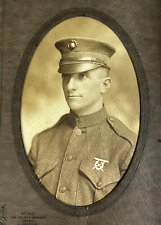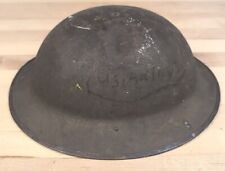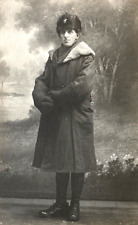

|
Site Categories |

|
Featured Items |

Poodle, Spaghetti Trim, Ucagco


|
WW1 Original German Imperial Navy Tally Band Collection - 32 Tallies plus For Sale


When you click on links to various merchants on this site and make a purchase, this can result in this site earning a commission. Affiliate programs and affiliations include, but are not limited to, the eBay Partner Network.

WW1 Original German Imperial Navy Tally Band Collection - 32 Tallies plus:
$2079.84
Original WW1 German Imperial Navy Other Ranks Cap Tally Band Collection (Kaiserliche Marine Tellermütze Mützenbanden). The tally bands have been stitched together on a wall hanging.There are 32 WW1 German Imperial Navy Cap Tally Bands plus two slogan tally bands, that were added to special \'end of service\' tallies, at either end. These were collected by a sailor who served on the German Raider S.M.S. Wolf. The prefix S.M.S. means Seiner Majestät Schiff (His Majesty’s Ship). Tally bands with red lettering, indicate the wearer was a cadet in training. Silver Bullion lettering indicates a fully qualified sailor in a Below Decks role (the \"Werft Division\"). This included a range of roles, including technicians, mechanics, craftsmen, support staff and stokers.All the tally bands have been stitched to a heavy backing banner. The tally bands are generally in good condition, except the S.M.S. Ostfriesland example, which is only fair. The banner was originally decorated with painted leaf designs around the edge, and the note \"1914-18\" in the bottom right. The initial year was changed at some point, and appears to have originally said 1912 (I think).The banner has a hole near the centre, at the base, and a number of small holes on the reverse, but these do not detract from this unique and very rare collection of tally bands.Included is a paperback edition of the book The Wolf by Richard Guilliatt & Peter Hohnen about the ship the sailor who collected these served on. This ship was part of the same task force as the S.M.S. Emden, and terrorised the Southern Oceans around Australia, during the First World War.Do not bother to ask if I will sell individual tally bands. I will not. It would be an immense task to pull this to pieces, and fraught with problems. This is an original item, and deserves to find a welcoming home.Ships and their wartime service as follows –S.M.S. WOLF - Armed merchant raider, equipped with six 15-cm guns, three 5.2-cm guns and several smaller calibre weapons and four torpedo tubes. She carried a small seaplane (called Wölfchen - Little Wolf). She was also a minelayer with over 450 mines. She laid one minefield off Australia\'s southern coast that claimed several ships. She had fake funnel and masts to change her appearance and false sides to keep her weapons hidden until the last possible moment. She destroyed 35 trading vessels and 2 war ships, altogether approximately 110,000 tons.S.M. TORPEDOBOOT TAKU - Built for the Chinese Navy as a destroyer in 1899. Captured by the Germans in 1900, during the Boxer Rebellion, and turned into a torpedo boat, on East Asian service. Sank in September 1914, whilst defending Kiautschou, the base of the East Asia Squadron in China.S.M.S. LOHRINGEN - Braunschweig class battleship commissioned in 1906. II Battle Squadron of the German High Seas Fleet. Participated in a fleet advance in December 1914 in support of the Raid on Scarborough, Hartlepool and briefly clashed with a detachment of the British Grand Fleet. Withdrawn from fleet service in 1916, after which she was used as a guard ship in the Baltic Sea, and later as a training ship.S.M.S. SEEADLER (Sea eagle) - Three-masted windjammer, and one of the last fighting steam/sail ships to be used in war. Built as US-flagged Pass of Balmaha. Captured by the German U-36, and in 1916 converted to be a merchant raider. Then had a successful raiding career, capturing and sinking 15 ships over a 225 day period, until wrecked in 1917, in French Polynesia.S.M.S. FRIEDRICH DER GROSSE (Frederick the Great) - Kaiser class battleship commissioned in 1912. III Squadron of the High Seas Fleet and served as fleet flagship until 1917. Participated in all major fleet operations of World War I, including the Battle of Jutland in 1916. Toward the centre of the German line, she was not as heavily engaged as the leading German ships, and emerged from the battle completely unscathed.S.M.S. FREYA - Victoria Louise class protected cruiser commissioned in 1900. Assigned to coastal defence. November 1914, removed from front line service and turned into a barracks ship. April 1915, became a training ship, and served in this capacity until the end of the war.S.M.S. KOENIG (King) - König class dreadnought battleship commissioned in 1914. Took part in most fleet actions during the war. Leading ship in the German line in the Battle of Jutland in 1916, König was heavily engaged by several British battleships and suffered ten large-calibre shell hits. In 1917, forced the Russian pre-dreadnought battleship Slava to scuttle itself during Operation Albion.S.M.S. KAISERIN (Empress) - Kaiser class battleship commissioned in 1913. III Battle Squadron and later IV Battle Squadron of the High Seas Fleet. Participated in all major fleet operations of World War I, including the Battle of Jutland in 1916. Also involved in Operation Albion in 1917. Saw action during the Second Battle of Heligoland Bight in 1917.S.M.S. ALICE ROOSEVELT - Torpedo boat, originally called D2, and renamed in 1902. Coast Defence Division Jade/Weser.S.M. TORPEDOBOOT S.90 - Torpedo boat. East Asia Squadron, and the only German warship to sink a warship of the Imperial Japanese Navy, by torpedoing Japanese cruiser/converted minelayer Takachiho in Chinese waters soon after the war began. The sinking caused at least 264 deaths.S.M.S. CHARLOTTE - Frigate cruiser/training ship commissioned in 1886. Decommissioned in 1909, but brought back into service in 1914, until replaced by the return of the Koenig Wilhelm.S.M.S. TSINGTAU - River Cannon Boat, launched in 1904. East Asia Squadron. Laid up in 1914 at Canton with skeleton crew for maintenance. Scuttled in 1917 in deep water to avoid capture by Chinese.S.M.S. SEYDLITZ - Unique (unclassed) battlecruiser commissioned in 1913. Participated in many large fleet actions during World War I, including the battles of Dogger Bank and Jutland in the North Sea. Suffered severe damage during both of these engagements, hit by 22 heavy calibre shells and a torpedo. Inflicted severe damage as well; destroying the British battlecruiser HMS Queen Mary in association with S.M.S. Derfflinger. Also saw some limited action in the Baltic Sea, providing screening for the German flotilla that attempted to clear the Gulf of Riga in 1915.III. HALBFLOTTILLE. III - Torpedo Boat Half Flotilla, consisting of Torpedo Boats S143 (leader, sank 1914 replaced by S138), S139, S140, S141, S142.S.M.S. SCHLESWIG-HOLSTEIN - Deutschland-class battleship commissioned in 1908. II Battle Squadron of the High Seas Fleet, up to the Battle of Jutland in 1916. Then relegated to guard duties in the Elbe River and decommissioned in late 1917. Returned to fleet service in the 1920s. In the early 1930s, converted into a training ship for naval cadets. Fired the first shots of World War II at the Polish base at Westerplatte in the early morning hours of 1 September 1939. Used as a training vessel for the majority of the war, and sunk by British bombers in 1944.S.M.S. HANSA - Victoria Louise class protected cruiser commissioned in 1898. East Asia Squadron during the Boxer Rebellion and the Battle of Taku Forts (1900), and was still in this unit during World War I.S.M.S. GNEISENAU - Scharnhorst class armoured cruiser commissioned in 1908. East Asia Squadron. In August 1914, with Scharnhorst, three light cruisers and several colliers, sailed across the Pacific ocean, evading various Allied naval forces, to arrive at southern coast of South America. In November 1914, encountered and overpowered a British squadron at the Battle of Coronel. Defeat prompted the British to send a British Task Force including two battlecruisers to hunt down and destroy the flotilla, which they did at the Battle of the Falkland Islands in December 1914.S.M.S. GOEBEN - Moltke class battlecruiser commissioned in 1912. Mediterranean Division, but after World War I started, she and Breslau evaded British naval forces and reached Constantinople. Both were transferred to the Ottoman Empire and she became the flagship of the Ottoman Navy as Yavuz Sultan Selim, usually shortened to Yavuz.S.M.S. BRESLAU - Magdeburg-class light cruiser commissioned in 1912. Transferred to the Ottoman Empire in 1914, to entice the Ottomans to join the Central Powers in World War I. Renamed Midilli. She was mined and sunk in January 1918, with the loss of the majority of her crew.S.M.S. POMMERN - Deutschland class battleship commissioned in 1907. II Battle Squadron of the High Seas Fleet, up to the Battle of Jutland in 1916. Hit by a 12 in (30.5 cm) shell from HMS Indomitable and one, or two, torpedoes from HMS Onslaught, which detonated a 17 cm gun magazine. Resulting explosion broke the ship in half and killed the entire crew.S.M.S. KOENIG WILHELM (King William) - Armoured frigate commissioned in 1869. Then the largest and most powerful German navy warship; and its flagship during the Franco-Prussian War in 1870–1871, though engine troubles prevented the ship from seeing action. In 1878, accidentally rammed and sank the Grosser Kurfürst, with great loss of life. Converted to an armoured cruiser in 1895–1896. Removed from active service in 1904. Used as a floating barracks and training ship up to the end of World War I.IX. HALBFLOTTILLE. IX. Torpedo Boat Half Flotilla, consisting of Torpedo Boats V6 (leader), V2, V3, V4, V5.S.M.S. KAISER (Emperor) - Kaiser class battleship commissioned in 1912. III Squadron of the High Seas Fleet. Participated in most major fleet operations during the war, including the Battle of Jutland in 1916, where she was hit once but suffered negligible damage. Also participated in Operation Albion in 1917, and at the Second Battle of Heligoland Bight in 1917.S.M.S. KOENIG ALBERT (King Albert) - Kaiser class battleship commissioned in 1913. III Battle Squadron and later IV Battle Squadron of the High Seas Fleet. Participated in most of the major fleet operations of World War I, but was in drydock during the Battle of Jutland in 1916, the only active battleship that missed the battle. Involved in Operation Albion in 1917.S.M.S. SCHARNHORST - Scharnhorst class armoured cruiser commissioned in 1907. East Asia Squadron. For war service, see S.M.S. Gneisenau.S.M.S. BRAUNSCHWEIG - Braunschweig class battleship commissioned in 1904. IV Battle Squadron of the German High Seas Fleet. In 1915, participated in the Battle of the Gulf of Riga, and engaged the Russian battleship Slava. In 1916, was placed in reserve owing to crew shortages. Spent rest of World War I as a training ship, and after 1917, as a barracks ship for U-boat crews.KAISERLICHE MARINE (Imperial Navy) was the German Navy created by the formation of the German Empire. It existed between 1871 and 1919.S.M.S. NASSAU - First German dreadnought battleship commissioned in 1908. II Division of the I Battle Squadron of the German High Seas Fleet. In 1915, participated in the Battle of the Gulf of Riga, and engaged the Russian battleship Slava. Following her return to the North Sea, she took part in the Battle of Jutland in 1916, where she collided with the British destroyer HMS Spitfire. Suffered 11 killed and 16 injured during the engagement.S.M.S. PREUSSEN - Braunschweig class battleship commissioned in 1905. II Battle Squadron of the German High Seas Fleet. Participated in a fleet advance in 1914 in support of the Raid on Scarborough, Hartlepool and Whitby during which the German fleet encountered and briefly clashed with a detachment of the British Grand Fleet. Assigned to guard ship duties in the Baltic and so missed the Battle of Jutland in 1916. Remained a guard ship until 1917, when she became a fleet tender.S.M.S. STRASSBURG - Magdeburg-class light cruiser commissioned in 1912. Damaged in the first Battle of Heligoland Bight in 1914. After World War I, she was ceded to Italy as a war prize, and renamed Taranto. Served in Italian Regia Marina (Royal Navy) until sunk by air attack in 1944.RESERVE S.M.S. OSTFRIESLAND. See S.M.S. Ostfriesland.S.M.S. OSTFRIESLAND - Helgoland class battleship commissioned in 1911. I Battle Squadron of the High Seas Fleet. Participated in all major fleet operations of World War I in the North Sea, including the Battle of Jutland in 1916. Also saw action in the Baltic Sea against the Russian Navy. Present during the unsuccessful first incursion into the Gulf of Riga in 1915.Also included are two \'end of service\' patriotic tally band additions -MIR ISTS ALS KEHRT DIE JUGEND WIEDER WENN AN DER MUETZ DER WIMPEL WEHTMe as the youths come back when on the cap the tallies wave.FROH KEHRE ICH ZUR HEIMAT WIEDER WOS AN DIE LIEBE ARBEIT GEHTGlad to return home again but I love to go to work.These tally bands are standard issue items. Worn on the \'Donald Duck\' style cap.Each is made of black silk with silver bullion or red lettering. The bullion is generally bright and relatively untarnished, apart from the S.M.S. Ostfriesland.These are all rare original tallies, not one of the many reproductions on the market..I will combine shipping for multiple purchases.

|
|
Related Items:
Vintage WW1 Era USMC U.S. Soldier Studio PORTRAIT PHOTO, Marine Corps $52.79

WW1 US M1917 Doughboy Helmet $75.00

RARE WW1 CANADIAN SIBERIAN EXPEDITIONARY FORCE SOLDIER PHOTO POSTCARD RPPC 1918 $195.00
|
|


|
Shopping Cart  |

|
Recently Viewed |

|
Latest Items |

|
Facebook |
Secure Websites

|








